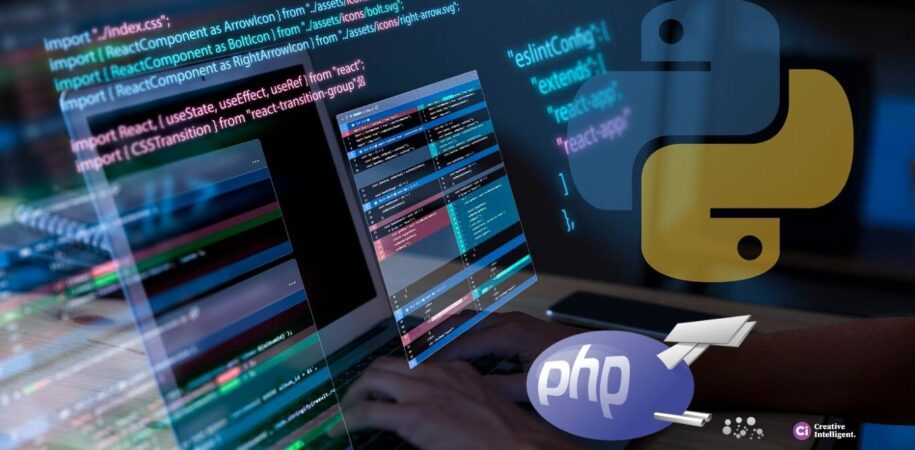When diving into the realm of web development, two prominent languages frequently stand out: PHP and Python. These programming languages hold their distinct flavors, catering to varied needs and preferences. Let’s take a stroll through the key differences that set PHP and Python apart in the landscape of web development.
Table of Contents
ToggleEase of Learning and Syntax
Learning a programming language can often mirror the experience of acquiring a new language. Python, in this analogy, emerges as a friendly companion, beckoning learners with its simplistic syntax akin to natural language. Its readability acts as a guiding beacon, akin to clear road signs on a journey, making the programming odyssey comprehensible and enjoyable. Python’s syntax, resembling human language structures, mitigates the steep learning curve, fostering a sense of ease and accessibility. Beginners often find solace in Python’s straightforwardness, enabling them to swiftly grasp concepts and embark on coding adventures with confidence.
Contrarily, PHP embraces newcomers with a different allure—an inviting lower learning curve, particularly tailored for web development novices. Its user-friendly design and immediate applicability in generating dynamic web content serve as a welcoming gateway into the realm of server-side scripting. PHP’s simplicity facilitates a quick initiation, enabling beginners to swiftly create interactive web pages and delve into server-side functionalities. This lower entry barrier aids novices in understanding web-oriented concepts efficiently, laying a foundation for their journey into the expansive world of web development. Both Python and PHP, in their distinctive ways, beckon learners into the realm of coding, offering varied yet inviting paths for exploration and skill acquisition.
Framework Availability
Python, renowned for its concise yet powerful frameworks, showcases Django and Flask as prominent choices. Django, an all-inclusive framework, streamlines complex tasks, fostering rapid development with its built-in features. Meanwhile, Flask, with its minimalistic approach, empowers developers to craft tailored solutions with flexibility. Conversely, PHP’s treasure trove of frameworks includes Laravel and Slim, renowned for their adaptability and scalability. Laravel, a robust MVC framework, simplifies intricate tasks, aiding in quick application development. Slim, a micro-framework, stands out for its minimalism, allowing developers to sculpt personalized solutions with lightweight efficiency, catering to diverse web development requisites.
Application and Language Type
Python’s versatility transcends conventional web development, expanding into machine learning, data science, and automation realms. Its prowess as a general-purpose language enables diverse applications beyond the web. Python’s libraries like NumPy and TensorFlow empower intricate data analysis and AI advancements, solidifying its foothold in futuristic technologies. Conversely, PHP excels in web-centric domains, specializing in crafting dynamic web content. With its primary focus on server-side scripting, PHP remains a go-to choice for web development, leveraging its capabilities to dynamically generate web pages, interact with databases, and facilitate seamless user experiences on the internet.
Maintainability and Debugging
Python tends to be more manageable in terms of maintenance compared to PHP. Its clean syntax and structure make it easier for developers to navigate and modify code. Debugging in Python often proves quicker, whereas PHP might require more time due to its intricacies.
Performance and Database Integration
Speed often becomes a decisive factor in programming languages, and here PHP holds a notable advantage over Python. PHP’s architecture and newer iterations showcase a remarkable edge in speed, sometimes exhibiting up to three times faster execution in specific scenarios compared to Python. This accelerated pace is pivotal in web development, especially for handling real-time data processing or rendering web pages swiftly.
Moreover, PHP’s compatibility with an extensive array of databases—over 20, to be precise—grants developers an extensive arsenal for data management. This versatility allows seamless integration with various database systems, empowering developers to choose the most suitable option for their specific project needs. The robust database support further fortifies PHP’s position in web development, ensuring efficient data handling and manipulation, a crucial aspect in creating dynamic and responsive web applications.
Community Support and Popularity
The community around a programming language is like a thriving ecosystem, fostering growth and innovation. Python’s popularity has surged significantly since 2016, gaining traction in various domains beyond web development. Conversely, PHP, once a dominant force, has seen a decline in popularity, particularly in forums like Stack Overflow.
Conclusion: Choosing the Right Tool
Both PHP and Python stand as stalwarts in the world of web development, each wielding its unique strengths. PHP excels in web-focused endeavors due to its simplicity and robustness. Python, on the other hand, offers a broader spectrum of applications beyond web development, owing to its versatility and ease of learning.
In the end, the choice between PHP and Python hinges on the project’s specific requirements and the developer’s preferences. While PHP remains steadfast in its domain-specific prowess, Python emerges as a versatile companion capable of addressing diverse programming needs.
In the vibrant landscape of web development, the choice between PHP and Python isn’t about which is superior; it’s about selecting the right tool to bring your digital vision to life.

